| Line 5: | Line 5: | ||
<br> | <br> | ||
| − | Outline of the Project:<br>A) What is a Markov Chain? <br>-Stochastic process<br>-Definition of Markov Chain<br>-Concrete examples and several properties<br>B) What can we do with it?<br> -Transition Probabilities and Transition Matrix<br> -Computation with Transition Matrix<br> -Matrix limits and Markov Chains<br>C) Why is a Markov Chain useful?<br> -Applications in Real Life with examples and computation (simple weather prediction model) <br>- Markov Chain and PageRank | + | Outline of the Project:<br>A) What is a Markov Chain? <br>-Stochastic process<br>-Definition of Markov Chain<br>-Concrete examples and several properties<br>B) What can we do with it?<br> -Transition Probabilities and Transition Matrix<br> -Computation with Transition Matrix<br> -Matrix limits and Markov Chains<br>C) Why is a Markov Chain useful?<br> -Applications in Real Life with examples and computation (simple weather prediction model) <br>- Markov Chain and PageRank |
<br>1.What is a Markov chain?<br>To answer this question, we need to know the definition of a stochastic process, because a Markov Chain is a special type of stochastic process. <br>Definition of a stochastic process:<br> “A sequence of random variables X1, X2,…,Xn is called a stochastic process with discrete time parameter n.” [1] | <br>1.What is a Markov chain?<br>To answer this question, we need to know the definition of a stochastic process, because a Markov Chain is a special type of stochastic process. <br>Definition of a stochastic process:<br> “A sequence of random variables X1, X2,…,Xn is called a stochastic process with discrete time parameter n.” [1] | ||
| Line 163: | Line 163: | ||
<br><br>One of the significant application involving Markov chains is PageRank. As demonstrated in the picture, it is a simulation of the Probability that surfer will visit each webpage at time t. Actually, the process is more complicated. To simplify it, we just consider the basic idea of Markov Chain, we assume that for each step, the surfer can either follow the links on the current website or jump randomly to another website in the network(the number of website is constant n). Namely, with probability P, the surfer will follow the link on the current website, and with chance of (1-P), he will jump to websites which have no link on the current website. | <br><br>One of the significant application involving Markov chains is PageRank. As demonstrated in the picture, it is a simulation of the Probability that surfer will visit each webpage at time t. Actually, the process is more complicated. To simplify it, we just consider the basic idea of Markov Chain, we assume that for each step, the surfer can either follow the links on the current website or jump randomly to another website in the network(the number of website is constant n). Namely, with probability P, the surfer will follow the link on the current website, and with chance of (1-P), he will jump to websites which have no link on the current website. | ||
| − | In order to have glimpse of how it works. I attach the codes of my CS class as follows. | + | <br>In order to have a glimpse of how it works. I attach the codes of my CS class as follows. |
| − | Suppose P = 0.75 and n = 5 | + | <br>Suppose P = 0.75 and n = 5 |
| − | web1 has link on web4, | + | <br>web1 has link on web4, |
| − | web2 has link on web1, | + | <br>web2 has link on web1, |
| − | web3 has link on web1, | + | <br>web3 has link on web1, |
| − | web4 has links on web2, web3 and web5, | + | <br>web4 has links on web2, web3 and web5, |
| − | web5 has link on web3 | + | <br>web5 has link on web3 |
Revision as of 14:26, 19 April 2014
What is a Markov chain/process? What can you do with it? And why are people talking about them?
Back to MA375 Spring 2014
Tianyi Zhang: zhan1035@purdue.edu ;
Sui Fang: fang52@purdue.edu ;
Christopher Peralta: cperalta@purdue.edu;
Lei Zhong: zhong9@purdue.edu ;
Nathan Accornero: naccorne@purdue.edu
Outline of the Project:
A) What is a Markov Chain?
-Stochastic process
-Definition of Markov Chain
-Concrete examples and several properties
B) What can we do with it?
-Transition Probabilities and Transition Matrix
-Computation with Transition Matrix
-Matrix limits and Markov Chains
C) Why is a Markov Chain useful?
-Applications in Real Life with examples and computation (simple weather prediction model)
- Markov Chain and PageRank
1.What is a Markov chain?
To answer this question, we need to know the definition of a stochastic process, because a Markov Chain is a special type of stochastic process.
Definition of a stochastic process:
“A sequence of random variables X1, X2,…,Xn is called a stochastic process with discrete time parameter n.” [1]
Explanation: We may think X1, X2,…,Xn as samples of an experiment. In a stochastic process, they represent the states of a process. Clearly, X1 is called the initial state and Xn represents the state at time n. In introductory probability courses, we are familiar with models that use X1,…,Xn as independently identically distributed (iid) random variables. However, note that states do not necessarily have to be independently identically distributed. This note is especially important to eliminate confusion for first time learners of Markov Chains.
Definition of a Markov Chain:
A stochastic process is a Markov Chain if, for every time n, the conditional distributions of all Xn+j(future state) given X1,…,Xn depend only on Xn(present state) and not X1,…,Xn-1(past states). In the majority or basic cases, we let j=1. That is, the probability distribution of random variable Xn is determined by the value from the (n-1)th state (Xn-1). This means the distribution of future states depend only on the present state, and has nothing to do with the past states.
*Note: In a Markov Chain, the value of present state only determines the “probability distribution of the future state”, it does not determine the exact value of the future states.
A concrete example:
Lets consider a person that has two choices of drinks for his breakfast every morning, milk or coffee. We let Xi=1 if the person chooses to drink milk on the i'th morning. Let Xi=2 if the person chooses to drink coffee on the i'th morning. In this case, the sequence of cases (random variables) X1, X2,…,xn is a stochastic process with two possible states at each time. To make it a Markov chain, consider that most people will usually switch rather than drink the same thing every day, and our person prefers milk more than coffee. Thus assume probability of that person choosing milk today given he chose milk yesterday is 0.3. The probability that he chooses coffee given he chose coffee yesterday is 0.2. Then this sequence of states becomes a Markov Chain.
P(Xn + 1 = 1 | Xn = 1) = 0.3, P(Xn + 1 = 2 | Xn = 1) = 1 − 0.3 = 0.7
P(Xn + 1 = 1 | Xn = 2) = 1 − 0.2 = 0.8, P(Xn + 1 = 2 | Xn = 2) = 0.2
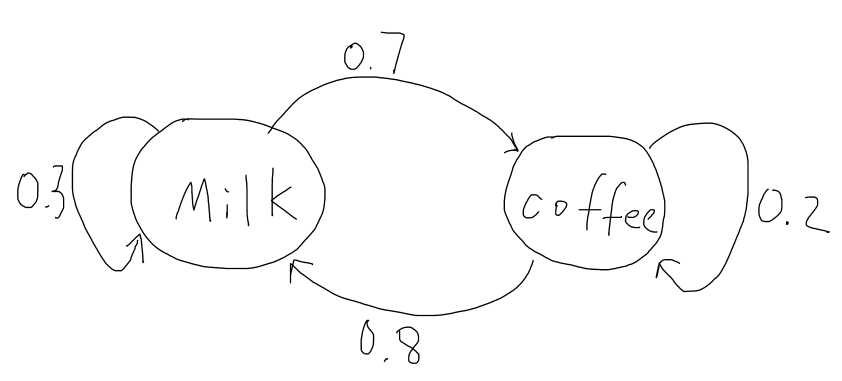
As you can see from the diagram, if the person drinks milk today there is a 30% chance he will drink it again tomorrow and there is a 70% chance he will drink coffee tomorrow.
What can we do with this?
Transition probabilities and Transition Matrix
We define Pij to be the probability that the future state is j given the present state is i.
P(Xn + 1 = j | Xn = i) = Pi''j
They are called transition distributions. If a Markov Chain’s transition distributions do not depend on n (just like the above example), then we can say the Markov Chain has stationary transition distributions.
In particular, a Markov Chain with stationary transition distributions can be represented by a Transition Matrix. For instance, the transition Matrix for the above Example is:
$ \begin{pmatrix} 0.3 & 0.7 \\ 0.8 & 0.2 \end{pmatrix} $
More Generally:$ P=\begin{bmatrix} P_{11} & \cdots & P_{1k} \\ \vdots & \ddots & \vdots \\ P_{k1} & \cdots & P_{kk} \end{bmatrix} $
General Rule for nth state distribution:$ x_n=x_{n-1}P $
Important Notes:
$ P_{ij} $ in the above matrix represents $ P(X_{n+1}=j|X_n=i) $, it turns out that the the sum of the entries in each row is 1 (This follows the same notation as my probability textbook and most of the professional articles I have found with online libraries). However, in some textbooks (for example, my linear algebra textbook) and resources I have found on the Internet, $ P_{ij} $ in the Matrix = $ P(X_{n+1}=i|X_n=j) $, this means the sum of every entry in each column is 1. To avoid confusion, we are going to follow the first notation style in this note.
The transition matrix makes computations in a Markov Chain much easier. In the breakfast example above (stationary transition probability), if we are given that a person drinks milk at time n,$ X_n=1 $, we can determine the probability distribution of $ X_{n+3} $. The initial state distribution can be written as a row vector : $ \begin{pmatrix}1 & 0\end{pmatrix} $
$ x_{n+3}=x_{n+2}P=(x_{n+1}P)P=((x_nP)P)P=x_nP^3=\begin{pmatrix}1 & 0\end{pmatrix} \begin{pmatrix} 0.3 & 0.7 \\ 0.8 & 0.2 \end{pmatrix}^3 $
$ x_{n+3}=\begin{pmatrix}0.475 & 0.525\end{pmatrix} $
This means given the person drinks milk today, three days later, there is a 47.5% chance he will drink milk and a 52.5% he will drink coffee.
- Matrix Limits and Markov Chains
In the Linear Algebra courses (MA351 and MA353 at Purdue University), we learn that a diagonalizable Matrix A can be represented in the form $ A=QDQ^{-1} $.
Where $ D=\begin{bmatrix} r_{1} & \cdots & 0 \\ \vdots & \ddots & \vdots \\ 0 & \cdots & r_n \end{bmatrix} $, where $ r_1...r_n $ are eigenvalues of the matrix A, and Q are has columns corresponding to the eigenvectors.
$ A^n=QDQ^{-1}QDQ^{-1}...QDQ^{-1}=QD^nQ^{-1}; \lim_{n \to \infty}A^n=\lim_{n \to \infty}(QD^nQ^{-1}) $.
Since D is a diagonal matrix, it’s very easy to compute its powers. In the breakfast example above, we are able to compute the matrix limits.
$ P=\begin{pmatrix} 0.3 & 0.7 \\ 0.8 & 0.2 \end{pmatrix} $;
The Characteristic Polynomial for P is:
$ (0.3-r)(0.2-r)-0.8*0.7=0; r_1=1; r_2=-0.5; Thus,D=\begin{pmatrix} 1 & 0 \\ 0 & -0.5 \end{pmatrix} $
Solving the linear systems, eigenvectors for P are:
$ \begin{pmatrix} 1 \\ 1 \end{pmatrix} and \begin{pmatrix} 7 \\ -8 \end{pmatrix}; Thus, Q=\begin{pmatrix} 1 & 7 \\ 1 & -8 \end{pmatrix} $;
$ \lim_{n \to \infty}P^n=\lim_{n \to \infty}(QD^nQ^{-1})=\lim_{n \to \infty}\begin{pmatrix} 1 & 7 \\ 1 & -8 \end{pmatrix} \begin{pmatrix} 1 & 0 \\ 0 & -0.5 \end{pmatrix}^n \begin{pmatrix} 1 & 7 \\ 1 & -8 \end{pmatrix}^{-1} $
$ =\lim_{n \to \infty}\begin{pmatrix} (8+7(-0.5)^n)/15 & 7/15 \\ (8-8(-0.5)^n)/15 &(7-8(-0.5)^n)/15 \end{pmatrix}= \begin{pmatrix} 8/15 & 7/15 \\ 8/15 & 7/15 \end{pmatrix} $
We put the initial condition into the equation:
$ \begin{pmatrix} 1 & 0 \end{pmatrix}\begin{pmatrix} 8/15 & 7/15 \\ 8/15 & 7/15 \end{pmatrix}=\begin{pmatrix} 8/15 & 7/15 \end{pmatrix} $
In fact, we will always get $ \begin{pmatrix} 8/15 & 7/15 \end{pmatrix} $ whether he drinks milk or coffee on the first day. This indicates that over a long time period, he will drink milk in 8/15 of days, and drink coffee in 7/15 of days.
Use MatLab to verify our result, just use n=1000:
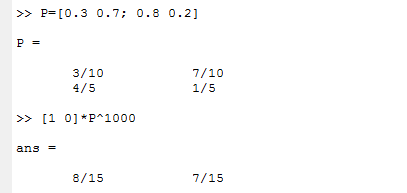
3. Why are people talking about Markov Chains?
- Applications of Markov Chains in Science and Real Life
Markov Chains have lots of applications in scientific research, because many things can be modeled using Markov Chains. In economics and finance, Markov Chains can help investors predict the volatility of asset returns. In biology, Markov chains can be used in population genetics research. In the simplest cases, Markov chains can be used in weather predictions.
We now construct a very simple sample case of weather prediction. Assume a city's weather has 3 distinct states: Sunny, Rainy and Overcast. These states, respectively, have the following sample space S= {0,1,2}. Suppose that the probability distribution of the next day only depends on the weather state of today (This is relatively reasonable in real cases), and given that:
$ P(X_{n+1}=Sunny|X_n=Sunny)=0.5 $;
$ P(X_{n+1}=Rainy|X_n=Sunny)=0.2 $;
$ P(X_{n+1}=Overcast|X_n=Sunny)=1-0.5-0.2=0.3 $;
$ P(X_{n+1}=Sunny|X_n=Rainy)=0.6 $;
$ P(X_{n+1}=Rainy|X_n=Rainy)=0.3 $;
$ P(X_{n+1}=Overcast|X_n=Rainy)=1-0.6-0.3=0.1 $;
$ P(X_{n+1}=Sunny|X_n=Overcast)=0.2 $;
$ P(X_{n+1}=Rainy|X_n=Overcast)=0.6 $;
$ P(X_{n+1}=Overcast|X_n=Overcast)=1-0.2-0.6=0.2 $;
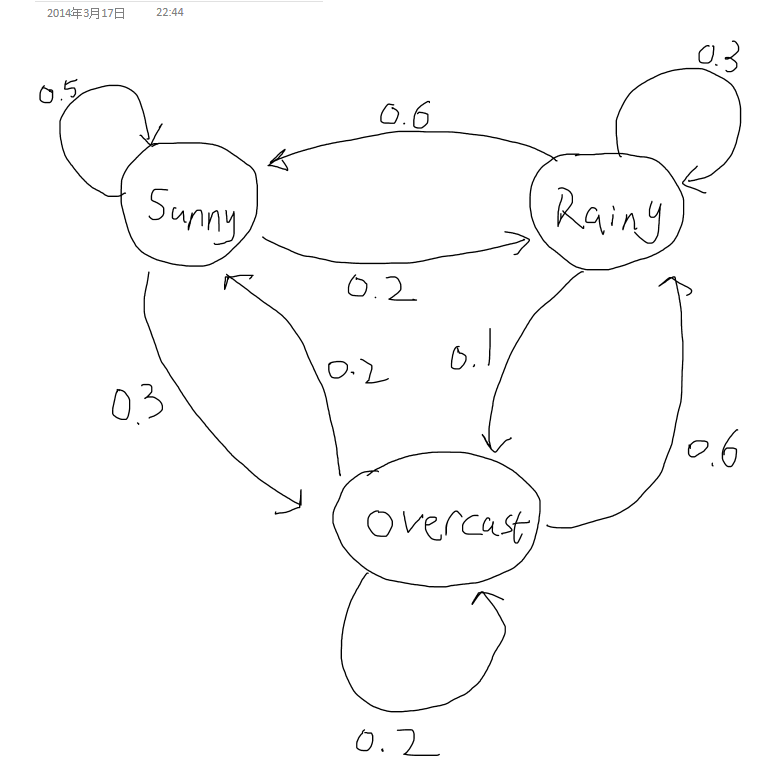
Transition Matrix P for this Model:
$ \begin{pmatrix} 0.5 & 0.2 & 0.3 \\ 0.6 & 0.3 & 0.1 \\ 0.2 & 0.6 & 0.2 \\ \end{pmatrix} $
Suppose we know the weather is overcast on Monday (Today), then we can determine the probability distribution of weather over the next several days (weather forecasting). For instance, on Wednesday:
$ x_{n+2}=x_{n}P^2=\begin{pmatrix} 0 & 0 & 1 \end{pmatrix} \begin{pmatrix} 0.5 & 0.2 & 0.3 \\ 0.6 & 0.3 & 0.1 \\ 0.2 & 0.6 & 0.2 \\ \end{pmatrix} \begin{pmatrix} 0.5 & 0.2 & 0.3 \\ 0.6 & 0.3 & 0.1 \\ 0.2 & 0.6 & 0.2 \\ \end{pmatrix} =\begin{pmatrix} 0.5 & 0.34 & 0.16 \end{pmatrix} $
This means on Wednesday, the probability is 0.5 for sunny, 0.34 for rainy and 0.16 for overcast given that Monday is overcast.
We can also use matrix limits to determine the long-term probability following the procedure in Part II. Since it’s little bit complicated to diagonalize a 3*3 matrix by hand, especially for a matrix with complex eigenvalues and eigenvectors, we use Matlab instead:
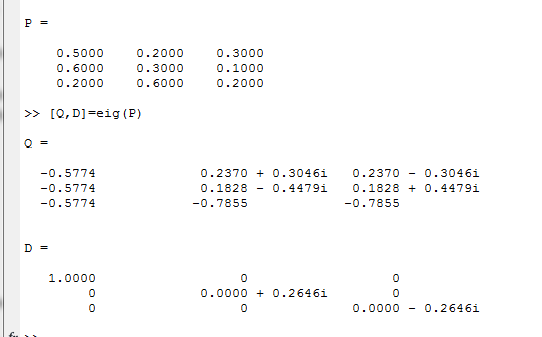
$ \lim_{n \to \infty}P^n=\lim_{n \to \infty}(QD^nQ^{-1})=\begin{pmatrix} 50/107 & 34/107 & 23/107 \\ 50/107 & 34/107 & 23/107 \\ 50/107 & 34/107 & 23/107 \\ \end{pmatrix} $
Therefore, for a single day randomly picked from the calendar, this city has a probability of 50/107 of sunny weather, 34/107 for rainy weather and 23/107 for overcast weather.
Verify this result with Matlab, take n=10000:
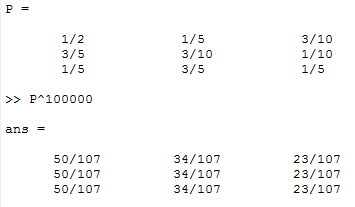
This weather model made by me is a very simple example of the real applications of Markov Chains. Many other models, such as PageRank used by Google, also use Markov Chains. Yet they are to complex to show on this webpage. Besides, we are not going to talk about some more advanced topics of Markov Chains, such as the Hidden Markov Model or Markov Chains in continuous time.
Application in PageRank
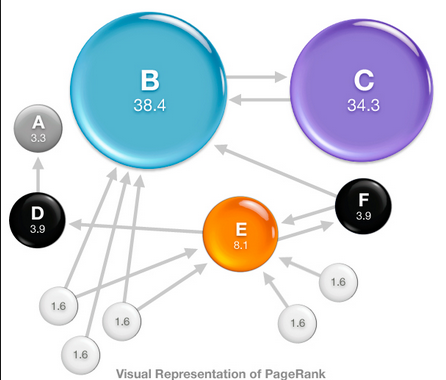
One of the significant application involving Markov chains is PageRank. As demonstrated in the picture, it is a simulation of the Probability that surfer will visit each webpage at time t. Actually, the process is more complicated. To simplify it, we just consider the basic idea of Markov Chain, we assume that for each step, the surfer can either follow the links on the current website or jump randomly to another website in the network(the number of website is constant n). Namely, with probability P, the surfer will follow the link on the current website, and with chance of (1-P), he will jump to websites which have no link on the current website.
In order to have a glimpse of how it works. I attach the codes of my CS class as follows.
Suppose P = 0.75 and n = 5
web1 has link on web4,
web2 has link on web1,
web3 has link on web1,
web4 has links on web2, web3 and web5,
web5 has link on web3
numsims = 5000; % Parameter controlling the number of simulations
G = [0 0 0 1 0; 1 0 0 0 0; 1 0 0 0 0; 0 1 1 0 1; 0 0 1 0 0];
n = length(G); % size of network
state = 1; % initial state of the system
p = 0.75; % probability of following link on web page
M = zeros(n,n); % create the matrix of probabilities
for i = 1:n;
for j = 1:n;
M(i,j) = p*G(i,j)/sum(G(i,:)) + (1-p)/n;
end
end
pages = zeros(1,n); % vector to hold number of times page visited
% Simulate a surfer's session for i=1:numsims
prob = rand;
if prob < M(state,1)
state = 1;
elseif prob < M(state,1) + M(state,2)
state = 2;
elseif prob < M(state,1) + M(state,2) + M(state,3)
state = 3;
elseif prob < M(state,1) + M(state,2) + M(state,3) + M(state,4)
state = 4;
else state = 5;
end;
pages(state) = pages(state) + 1;
if ~mod(i,numsims/5)
fprintf('%6d %5.3f %5.3f %5.3f %5.3f %5.3f \n',i,pages/sum(pages));
end
end
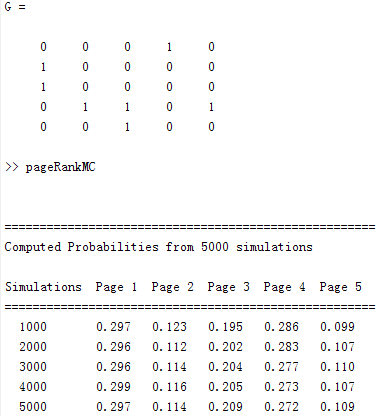
If we increase the number of simulation to 500000, we can see a more stable pattern.
The results is
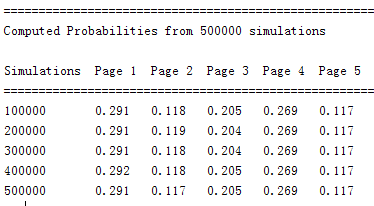
Discussion: Even Markov Chain is great idea in this PageRank simulation example, there is still some challenge things we need to improve. First, the number of pages on the internet is not constant. Secondly, the links of on each webpage will change. Thirdly, the probability actually is really hard to be a constant. That is why we need other theories to improve our strategy, like Time Series and Stochastic Process.
This project was originally conducted by Office Word, a link for the PDF file (already uploaded to this site)
can be found
References and Theorems & knowledge Sources:
- Morris H. Degroot, Mark J. Schervish, Probability and Statistics, 4th edition
- Michael J. Evans, Jeffery S. Rosenthal, Probability and Statistics: The Science of Uncertainty, 2nd edition
- Stephen H. Friedberg, Arnold J. Insel, Linear Algebra, 4th edition
- Anne Greenbaum & Timothy P. Chartier, Numerical Methods, 1st edition

